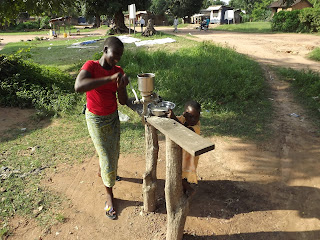I have been excited about doing this post for sometime now. It has taken me a while to gather all the correct photos to explain the processing phenomenon that happens here. I knew that cassava was an important crop, but I did not know its history, its properties, or the complex process this culture engages to utilize it. As a matter of fact, it would be impossible to overstate its value to the people here.
Cassava was imported here nearly 500 years ago by the Portuguese from Brazil as a hardy food source for slaves I think. Much like Captain Bligh's eventual introduction of breadfruit to Jamaica. It grows all year round, and the leaves and root are edible (sort of). There are two types, a common variety and a bitter variety, both of which naturally produce a type of cyanide - the latter in much greater quantities. Although it is seldom lethal, the unprocessed chemicals can lead to goiters and other health problems. The upside is that this propensity makes the plant highly resistant to pests. As I mentioned, I did not know this when I came here, having eaten cassava often in Jamaica many years ago (the common type I suppose). So I was perplexed by the elaborate processing industry here and the multitude of steps it took to get this vital staple to market. The methods are old, but they help remove the toxins from the plant. Here is a short summary of the cassava processing steps:
Cassava was imported here nearly 500 years ago by the Portuguese from Brazil as a hardy food source for slaves I think. Much like Captain Bligh's eventual introduction of breadfruit to Jamaica. It grows all year round, and the leaves and root are edible (sort of). There are two types, a common variety and a bitter variety, both of which naturally produce a type of cyanide - the latter in much greater quantities. Although it is seldom lethal, the unprocessed chemicals can lead to goiters and other health problems. The upside is that this propensity makes the plant highly resistant to pests. As I mentioned, I did not know this when I came here, having eaten cassava often in Jamaica many years ago (the common type I suppose). So I was perplexed by the elaborate processing industry here and the multitude of steps it took to get this vital staple to market. The methods are old, but they help remove the toxins from the plant. Here is a short summary of the cassava processing steps:
The cassava plants grow along corn and other taller plants
The roots are big and grow quickly
The soaking stage confused me as they would then dry the cassava for several days letting it ferment. I knew they weren't making an alcoholic drink out of it. It is one of those in-between smells that is attractive for half a second then sort of sickly sweet.
Every other house has a plastic tarp spread out for drying the cassava root.
After they are soaked they are chopped and the dried product is in chips
In Zongo and a few other places, there are gas operated grinding mills. This is the main mill in the big market in town that produces a great deal of cassava flour.
If you don't have a gas grinder, there are other means available
And if you are a traditionalist, you can do it they way they always have.
The leaves are a different story. They must be smashed and tenderized.
Off to the market to package and sell.
A slow day.
There are many uses for cassava here. In this case, the flour is made into a paste then steamed in a husk to make cassava bread
The dish on the right is cassava leaves. They are pulverized, fried, and served with a sauce.
The most popular form of cassava is Fufu - the cassava flour is rolled into a ball then boiled. You pinch off a small chunk, flatten it a bit, and then dip it into meat or vegetables.
This is just one of three industries that thrive here - the other two being charcoal and brick making. Posts to come soon :)



















And what do the cassava leaves taste like? Collard greens? Kale? Spinach? Moulikhia? I wonder if they bake cakes with the cassava flour? I'm sure they can and then would be able to sell it along side the cassava bread husk??
ReplyDeleteManal K. :)
The leaves were different. They were smashed as they are tough. It is hard to described but I liked it. Haven't seen any cakes, lol, but I am looking :)
ReplyDelete